
The Chicago Water Tower is a contributing property and landmark in the Old Chicago Water Tower District in Chicago, Illinois, United States, that is listed on the National Register of Historic Places. Built to enclose the tall machinery of a powerful water pump in 1869, it became particularly well known when it survived the Great Chicago Fire of 1871, although the area around it was burnt to the ground.

The Old Chicago Water Tower District is a historic district along the Magnificent Mile shopping district in the Near North Side community area of Chicago, Illinois. The district is located on both sides of North Michigan Avenue between East Chicago and East Pearson Streets. It includes the Chicago Water Tower, Chicago Avenue Pumping Station, and Chicago Fire Department Fire Station No. 98. All three structures are part of the Chicago Landmark district designated on October 6, 1971. The Water Tower and Pumping Station were jointly added to the National Register of Historic Places on April 23, 1975. In addition the Tower was named an American Water Landmark in 1969. The Water Tower was also one of the few buildings to survive the Great Chicago Fire. The district is the namesake of the nearby Water Tower Place.

The Soul Harvest Ministries is located at 16300 Woodward Avenue in Highland Park, Michigan. It was built in 1916 as the First United Methodist Church and listed on the National Register of Historic Places in 1982.

Trinity Episcopal Church is located at 1519 Martin Luther King Boulevard in the Woodbridge Historic District of Detroit, Michigan. The church was designated a Michigan State Historic Site in 1979 and listed on the National Register of Historic Places in 1980. It is now known as Spirit of Hope.

Garden Court Condominiums is a condominium building located at 2900 East Jefferson Avenue in Detroit, Michigan. It was listed on the National Register of Historic Places in 1985.
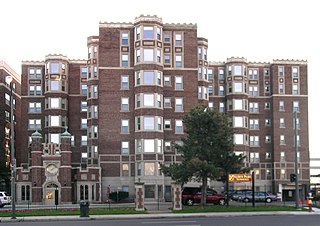
The Alden Park Towers consists of a compound of four, eight-story luxury apartment buildings located at 8100 East Jefferson Avenue along the Gold Coast in Detroit, Michigan. It is currently known as Alden Towers. The collective of structures was listed on the National Register of Historic Places in 1985.

The John A. Green Estate is a historic property in Stone City, Iowa, United States. The estate covers 200 acres (0.81 km2) of land. The buildings were constructed of Anamosa Limestone quarried from John Green's own local business. The estate was individually listed as a historic district on the U.S. National Register of Historic Places in 1978. It was included as a contributing property in the Stone City Historic District in 2008.
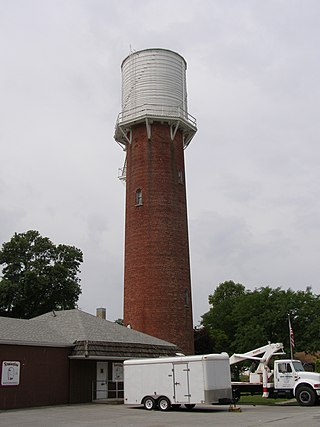
The Water Tower was built in 1897 by Challenge Wind and Feed mill Company of Batavia, Illinois. This is a rare wooden tank atop a brick tower type of water tower. Built on a limestone foundation, it is 140 feet (43 m) tall and about 20 feet (6.1 m) in diameter. The brick walls are 2 feet (0.61 m) thick.

The Michigan Bell and Western Electric Warehouse is a former commercial warehouse building located at 882 Oakman Boulevard in Detroit, Michigan. It was listed on the National Register of Historic Places in 2009. It is now known as the NSO Bell Building.

The Manistique Pumping Station is an industrial waterworks building located on Deer Street in Manistique, Michigan. It was listed on the National Register of Historic Places in 1981.
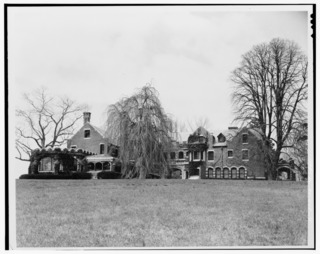
Fort Hill Estate is a historic estate located at Lloyd Harbor in Suffolk County, New York. The estate home is a monumental brick and limestone Tudor Revival style structure built as a summer home in 1879, and enlarged in 1900. It is a three-story mansion with an irregular, asymmetrical and sprawling plan which is roughly "C" shaped. It features a conical tower built as part of the original structure, designed by McKim, Mead, and White. Also on the estate are a formal garden, a water tower, a superintendent's house, two garages, and a cottage.

Gethsemane Lutheran Church is a historic Lutheran church in downtown Austin, Texas. Designated as a Recorded Texas Historic Landmark and listed on the National Register of Historic Places, the building currently holds offices of the Texas Historical Commission.

St. Lawrence Catholic Church is a parish of the Archdiocese of Dubuque. It is located in rural Jackson County, Iowa, United States, in Otter Creek Township. It was listed on the National Register of Historic Places in 1992.

The Adair County Courthouse, located in Greenfield, Iowa, United States, was built from 1891 to 1892. It was individually listed on the National Register of Historic Places in 1981 as a part of the County Courthouses in Iowa Thematic Resource. In 2014 it was included as a contributing property in the Greenfield Public Square Historic District. The courthouse is the third structure to house county courts and administration offices.

The Bradford Community Church, originally the Henry M. Simmons Memorial Church and later the Boys and Girls Library, is a historic church built in 1907 in Kenosha, Wisconsin, United States under the leadership of Kenosha's first woman pastor.

The Clark–Blackwell House is an historic residence located in Muscatine, Iowa, United States. It has been listed on the National Register of Historic Places since 1983. The house was included as a contributing property in the West Hill Historic District in 2008.
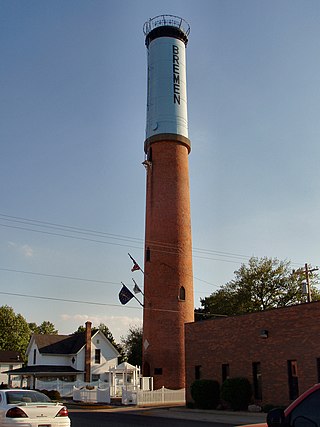
Bremen Water Tower, also known as Bremen Water Works Standpipe, is a historic water tower located at Bremen, Marshall County, Indiana. It was built in 1892, and consists of a 68 foot tall brick base with Second Gothic Revival style design elements topped by a 36 foot tall tank. The base sits on a limestone foundation and is 13 feet in diameter. It was taken out of commission in 1955. It remains a community icon and was named an American Historic Water Landmark in 1975.

Upper Paradise is a historic building located west of Bellevue, Iowa, United States. It is one of over 217 limestone structures in Jackson County from the mid-19th century, of which 101 are houses. It is one of 12 houses with a hip roof, and it is one of two that are capped with a belvedere. It was built in 1849 into the side of a hill, so the south elevation has three floors and the north elevation has two. It features limestone sills and lintels. Another unusual feature of this house is that it was covered in a thick layer of stucco. The other stone houses in the county that were stuccoed were only given a thin layer. The house was listed on the National Register of Historic Places in 1991.
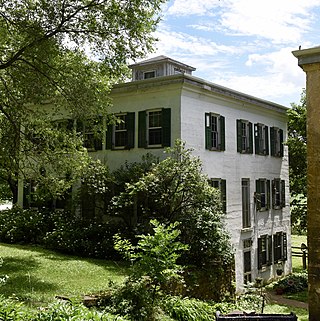
Paradise Farm are historic agricultural and domestic buildings located west of Bellevue, Iowa, United States. Massachusetts native Elbridge Gerry Potter settled near Big Mill Creek in 1842 from Illinois. He arrived here with 500 head of cattle, 40 teams of mules, and money. In addition to this farm he operated a flour mill and sawmill in Bellevue, and established steamboat lines on the Mississippi River at Bellevue, on the Yazoo River in Louisiana and the Red River in Texas.
The Manning Water Tower is a historic structure located in Manning, Iowa, United States. It is significant as a good example of early 20th-century steel elevated water tower design, and its association with Anson Marston and the Chicago Bridge & Iron Company. Marston, who designed the structure, was a professor of engineering at Iowa State College. Manning native Henry J. Brunnier, who studied under Marston, convinced the city council to use one of Marston's designs rather than a less expensive standpipe. He also assisted with this water tower's design, and went on to career as a civil engineer in San Francisco. Also involved in the tower's design was the Chicago Bridge & Iron Company, who built it in 1903. It replaced a pump house with a steam-powered engine and a large water tank that was built near the town's well in 1894. The water tower is 140.75 feet (42.90 m) tall. It has a 60,000-US-gallon (230 kl) steel tank, with a cast-iron center pipe, and four steel legs. The superstructure rests on concrete piers with limestone capstones, and the tank is capped with a pagoda-shaped roof. The water tower was listed on the National Register of Historic Places in 2016.





















